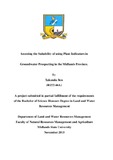Please use this identifier to cite or link to this item:
https://cris.library.msu.ac.zw//handle/11408/2135| Title: | Assessing the suitability of using plant indicators in groundwater prospecting in the Midlands Province | Authors: | Takunda, Ben | Issue Date: | 2015 | Publisher: | Midlands State University | Abstract: | There have been challenges in groundwater prospecting especially in the Midlands Province of Zimbabwe. Prospecting has not been accurate with frequent occurrences of dry holes for both geophysical and traditional groundwater prospecting techniques. The study involved an assessment of the suitability of using plant indicators for ground water prospecting in the Midlands Province of Zimbabwe. To achieve this, indicator species were first identified and their abundances and biometric characteristics were used to predict borehole yields and depths. The study area is dominated by bush and tree savanna and hence it was necessary to establish and eliminate baseline species from the study. After elimination of baseline species, five species were identified as indicators. The relationships between indicator species’ biometric characteristics / species abundances and borehole depths / yields were determined through regression analysis. Identified species were Acacia burkei benth, Acacia negrecens, Lonchocarpus capassa, Piliostigma thonningii and Sclerocarya birrea caffra. Acacia burkei benth, Acacia negrecens and Lonchocarpus capassa were the most powerful indicators in that order in terms of yield prediction respectively. Piliostigma thonningii and Sclerocarya birreacaffra showed the ability to form combinations with both Acacia negrecens and Lonchocarpus capassa but however they were not confined to any yield ranges. The biometric characteristics of the indicator species had weak correlations with borehole depth and yields (0 < R < 0.38). The study also showed that there exists a strong positive linear relationship between the abundance of Acacia negrecens (R = 0.68) and the yield of boreholes. Finally, Sclerocarya birrea caffra was discovered to also have a strong linear relationship (R = 0.78) with borehole depth. The identified indicator species can be used for identification of ground water sites but it is not possible to predict the yield and depth of boreholes using species’ biometric characteristics in the study area. | URI: | http://hdl.handle.net/11408/2135 |
| Appears in Collections: | Bsc Land And Water Resources Management Honours Degree |
Files in This Item:
| File | Description | Size | Format | |
|---|---|---|---|---|
| Assessing the suitability of using plant indicators.pdf | 846.42 kB | Adobe PDF |  View/Open |
Page view(s)
152
checked on Feb 24, 2025
Download(s)
48
checked on Feb 24, 2025
Google ScholarTM
Check
Items in MSUIR are protected by copyright, with all rights reserved, unless otherwise indicated.



